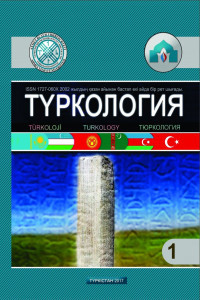ARABIC-MUSLIM CULTURE LITERATURE TRADITIONS IN R.FAKHRETDINOV’S POEMS
The article attempts to analyze the work of the scholar-educator R. Fakhretdinov in the context of the traditional Arab-Muslim culture. The object of the analysis are the story "Salima or chastity", "Asma or act and punishment" and the popular scientific work "Muhammad (peace be upon him)" in the light of contemporary literary research. "Salima or chastity" in its content is a secular work that has real foundations. Characters act as representatives of specific peoples, the time of action is precisely indicated, etc. This is like an exposition: it gives the background to the work, prepares the reader for further events, including posing a problem that everyone should ponder - the serious lag of the Muslim peoples in the cultural and educational aspect. The heroes of the story of Salim and the Shakird "B" can be an example for the younger generation. All the happy and unhappy turns in the fate of the main characters are the consequence and result of the moral, enlightened or immoral behavior of the characters. The reader perceives the worldview perspectives reflected in the work, the humanistic values and ethical principles of the author as their internal beliefs and moral norms of behavior. Analysis of the work "Muhammad (peace be upon him)" shows that this is mostly a scientific and historical work. The author deduces the dates for the Hijra and the Gregorian calendar, which was due to the actively changing life of the early twentieth century.
Thus, the literature of the second half of the nineteenth and early twentieth centuries, synthesizing the artistic traditions of national folklore and Arab-Muslim culture, occupies a special place. Its aesthetic and artistic traditions were continued in the prose and poetry of the 20th century, it was the basis of national literature, the source of creativity of the greatest writers and poets of the 20th century.
Keywords:
Imade, Education, Story, R.Fakhretdinov, Bashkir literature Arab-Muslim literature,
___
- 1. Сибагатов Ф. Ш. Ранее творчество Мажита Гафури в контексте типологии башкирской духовной литературы // Проблемы востоковедения. 2016. №3 (73). С.51–55.
- 2. Сибагатов Ф. Ш. Духовная литература башкирского народа. Уфа: Гилем, 2015. 152 с.
- 3. Федоров А. А. Введение в теорию и историю культуры. Уфа: Гилем, 2003.
- 4. Корман Б. О. Избранные труды по теории и истории литературы. Ижевск: Изд-во Удмуртского университета, 1992. 236 с.
- 5. Кунафин Г. С. Жанровая природа прозы Ризы Фахретдинова // Творчество Ризы Фахретдинова. Уфа, 1988. (на башк. яз.).
- 6. Фахретдинов Р. Асма Или поступок и наказание. Оренбург, 1903.
- 7. 10. Фахретдинов Р. Мухаммад (мир ему). Оренбург, 1909. 44 с. (на тюрки).
- 8. Бахтин М. Эстетика словесного творчества. М.: Искусство, 1986. 445 с.
- 9. Ислам. Энциклопедический словарь. М.: Наука, 1991. 315 с.
- 10. Сибагатов Ф. Ш. Сират ан-наби как жанр религиозно-дидактического характера в башкирской литературе начала XX века // Проблемы востоковедения. 2015. №4(70). С.55–59.
- 11. Хрестоматия по исламу / Сост. и отв. ред. С.М. Прозоров. М.: Наука, 1994. 238 с.
- ISSN: 1727-060X
- Başlangıç: 2002
- Yayıncı: Hoca Ahmet Yesevi Uluslararası Türk-Kazak Üniversitesi
